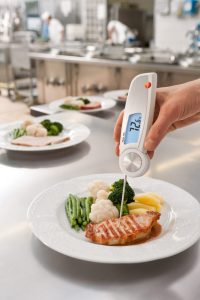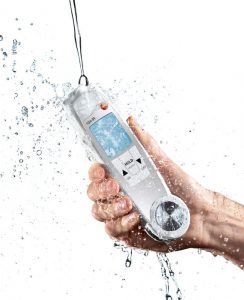Digital thermometers from a reputable supplier are an essential monitoring tool in most food facilities. Many CCPs are monitored by temperature checks and this is because heat (or the lack of it) is used to control the growth or kill micro-organisms.
Modern thermometers are electronic and feature microprocessor driven probes or even detectors capable of reading infrared radiation but around 300 years ago temperature measurement as a science was in its infancy. In 1714 Daniel Gabriel Fahrenheit invented the mercury in glass thermometer and went on 10 years later to develop the temperature scale that bears his name. Fahrenheit used three reference temperatures to form his scale. Firstly, he assigned a frigorific mixture of salt, ice and water at 0. The temperature that ice started to form on fresh water was assigned 32 and the temperature of his underarm was assigned 96. The freezing point to boiling point of water was divided in 180 degrees and the Fahrenheit scale was born!
In 1742 Anders Celsius developed a new scale that would go on to be used by almost the entire world and be designated as an SI unit. Celsius assigned the melting point of ice the unit 100 and the boiling point of water at 1atm to be 0. He then divided these reference points by 100 to invent the Centigrade scale. Centigrade is derived from the Latin for hundred steps. A year after Celsius’s death in 1745, the scale was reversed such that 0o represented the melting point of water and 100o the boiling point. This represents a common calibration method for Celsius thermometers to this day.
Today there are hundreds of different thermometers available and some of the considerations for selecting a thermometer for your food business include the following.
 Type. The first choice is one of digital vs analog. ‘Analog’ instruments include the traditional mercury in glass and also the bi-metalic or dial thermometers. Never use mercury in glass or alcohol in glass thermometers anywhere near food. Breakages can cause toxic chemicals and glass to enter food. Dial thermometers have low accuracy, are somewhat difficult to read with precision below a degree and are easily shocked out of calibration. Really, for food processing applications, a digital thermometer is a must and can offer easy to read precision resolution, accuracy and a robust construction.
Type. The first choice is one of digital vs analog. ‘Analog’ instruments include the traditional mercury in glass and also the bi-metalic or dial thermometers. Never use mercury in glass or alcohol in glass thermometers anywhere near food. Breakages can cause toxic chemicals and glass to enter food. Dial thermometers have low accuracy, are somewhat difficult to read with precision below a degree and are easily shocked out of calibration. Really, for food processing applications, a digital thermometer is a must and can offer easy to read precision resolution, accuracy and a robust construction.
Subtype of digital. Thermocouple or thermistor / RTD or IR is a choice the purchaser needs to make based on intended usage. Thermocouples typically have a wider range, are easily calibrated and offer flexibility in use such as being able to insert the junction tip into a can during processing. Thermistors are common, cost effective and accurate. Good quality thermistor thermometers rarely go out of calibration and can be purchased with a wide variety of probe types for different applications. RTDs are accurate across a larger range but can be difficult for field (factory) calibrations. IR Thermometers are contactless and useful for applications where a probe or direct contact is not practical. A value is resolved rapidly but these instruments have limitations such as only measuring the temperature of the surface, not being simple to calibrate and opportunity for incorrect reading because of reflections of IR radiation from non-target sources.
Probe. The probe should be made of stainless steel and of a suitable length for the application. As these are typically hand held units, the purchaser must consider how close they want their hand to be to the test when conducting a measurement. For example, if measuring the temperature of a large boiling vat of food, a longer probe will be safer and easier to use than a shorter probe. Probes attached to the thermometer via a cable can be easy to use in certain applications compared to a fixed probe unit. The strength of the probe is also a consideration when measuring hard substances such as frozen foods. Specially designed and super-robust probes can be obtained for boring into solid foods. Other probes can be obtained for measurement of surface temperatures and other specialist applications.
 Housing. A waterproof and cleanable housing is strongly recommended for food applications. Smooth surfaces will provide for effective cleaning…. after all, the thermometer could be considered a food contact surface. A robust housing will help to prevent damage to the instrument from the inevitable drops and shocks they will receive when used in food processing application. Avoiding glass components or anything that can break off the unit and become a contaminant is prudent for food applications.
Housing. A waterproof and cleanable housing is strongly recommended for food applications. Smooth surfaces will provide for effective cleaning…. after all, the thermometer could be considered a food contact surface. A robust housing will help to prevent damage to the instrument from the inevitable drops and shocks they will receive when used in food processing application. Avoiding glass components or anything that can break off the unit and become a contaminant is prudent for food applications.
Features. Quality brands offer a range of useful features such as reading hold, memory, stabilisation hold, Hi/Lo memory, duel probe / IR and downloadable / IoT options to name a few. All are useful and can assist usability in different applications. Make sure the readout is legible in different light situations and consider requirements in either dark or extremely bright applications.
Accuracy and resolution. Both are determined by application but for a general-purpose thermometer a resolution of 0.1 degrees and a matching accuracy in the target temperature range is considered adequate. Where temperature measurement of Critical Control Points is required, higher levels of accuracy and resolution may be required.
Typically, as part of your Food Safety Management Programme, you will need to calibrate your thermometers on a routine basis. This may include benchtop calibration by the instrument manufacturer or comparison to a reference thermometer over a number of temperatures in the target usage range. Check the instrument manufacturer recommendations in this regard. Of course, in the field (factory), the methodology developed using ice water and boiling water by Anders Celsius some 300 years ago is still the easiest, most common and effective method.
Instruments that have been certified by HACCP International display all characteristics as recommended in this article.

By Martin Stone,
Technical Director, HACCP International
